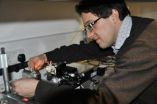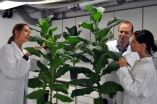(Press-News.org) The University of Southampton's Optoelectronics Research Centre (ORC) is pioneering research into developing the strongest silica nanofibres in the world.
Globally the quest has been on to find ultrahigh strength composites, leading ORC scientists to investigate light, ultrahigh strength nanowires that are not compromised by defects. Historically, carbon nanotubes were the strongest material available, but high strengths could only be measured in very short samples just a few microns long, providing little practical value.
Now research by ORC Principal Research Fellow Dr Gilberto Brambilla and ORC Director Professor Sir David Payne has resulted in the creation of the strongest, lightest weight silica nanofibres – 'nanowires' that are 15 times stronger than steel and can be manufactured in lengths potentially of 1000's of kilometres.
Their findings are already generating extensive interest from many companies around the world and could be set to transform the aviation, marine and safety industries. Tests are currently being carried out globally into the potential future applications for the nanowires.
"With synthetic fibres it is important to have high strength, achieved by production of fibre with extremely low defect rates, and low weight," says Dr Brambilla.
"Usually if you increase the strength of a fibre you have to increase its diameter and thus its weight, but our research has shown that as you decrease the size of silica nanofibres their strength increases, yet they still remain very lightweight. We are the only people who currently have optimised the strength of these fibres.
"Our discovery could change the future of composites and high strength materials across the world and have a huge impact on the marine, aviation and security industries. We want to investigate their potential use in composites and we envisage that this material could be used extensively in the manufacture of products such as aircraft, speedboats and helicopters," he adds.
Professor Payne explains: "Weight for weight, silica nanowires are 15 times stronger than high strength steel and 10 times stronger than conventional GRP (Glass Reinforced Plastic). We can decrease the amount of material used thereby reducing the weight of the object.
"Silica and oxygen, required to produce nanowires, are the two most common elements on the earth's crust, making it sustainable and cheap to exploit. Furthermore, we can produce silica nanofibres by the tonne, just as we currently do for the optical fibres that power the internet."
The research findings came about following five years of investigations by Dr Brambilla and Professor Payne using Gilberto's £500,000 Fellowship funding from the Royal Society.
Dr Brambilla shared his findings with fellow researchers at a special seminar he organised recently at the Kavli Royal Society International Centre, at Chicheley Hall, in Buckinghamshire.
"It was particularly challenging dealing with fibres that were so small. They are nearly 1,000 times smaller than a human hair and I was handling them with my bare hands," says Dr Brambilla.
"It took me some time to get used to it, but using the state-of-the-art facilities at the ORC I was able to discover that silica nanofibres become stronger the smaller they get. In fact when they become very, very small they behave in a completely different way. They stop being fragile and don't break like glass but instead become ductile and break like plastic. This means they can be strained a lot.
"Up until now most of our research has been into the science of nanowires but in the future we are particularly interested in investigating the technology and applications of these fibres," adds Dr Brambilla.
INFORMATION:
To find out more about the ORC's work on silica nanowires go to: www.orc.soton.ac.uk/omfds.html or www.orc.soton.ac.uk.
Southampton scientist develops strongest, lightest glass nanofibres in the world
2013-01-10
ELSE PRESS RELEASES FROM THIS DATE:
Solving puzzles without a picture
2013-01-10
One of the most difficult problems in the field of genomics is assembling relatively short "reads" of DNA into complete chromosomes. In a new paper published in Proceedings of the National Academy of Sciences an interdisciplinary group of genome and computer scientists has solved this problem, creating an algorithm that can rapidly create "virtual chromosomes" with no prior information about how the genome is organized.
The powerful DNA sequencing methods developed about 15 years ago, known as next generation sequencing (NGS) technologies, create thousands of short fragments. ...
Marriage linked to better survival in middle age
2013-01-10
Could marriage, and associated companionship, be one key to a longer life? According to new research, not having a permanent partner, or spouse, during midlife is linked to a higher risk of premature death during those midlife years. The work, by Dr. Ilene Siegler and colleagues from Duke University Medical Center in the US, is published online in Springer's journal Annals of Behavioral Medicine.
Survival through middle age to become elderly is expected; therefore understanding who does not survive to become elderly and why is important. Siegler and colleagues looked ...
Banded mongooses structure monosyllabic sounds in a similar way to humans
2013-01-10
This press release is available in German.
Animals are more eloquent than previously assumed. Even the monosyllabic call of the banded mongoose is structured and thus comparable with the vowel and consonant system of human speech. Behavioral biologists from the University of Zurich have thus become the first to demonstrate that animals communicate with even smaller sound units than syllables.
When humans speak, they structure individual syllables with the aid of vowels and consonants. Due to their anatomy, animals can only produce a limited number of distinguishable ...
New report: The reach and impact of mathematical sciences
2013-01-10
The Mathematical Sciences in 2025, a new report from the National Research Council, finds that the mathematical sciences are an increasingly integral component of many disciplines -- including biology, medicine, the social sciences, business, advanced design, and climate studies. However, the expanding role of the mathematical sciences over the past 15 years has not been matched by a comparable increase in federal funding, and the number of federal agencies that provide significant support for this research is considerably smaller than the number that profit from it.
The ...
Is there a period of increased vulnerability for repeat traumatic brain injury?
2013-01-10
New Rochelle, NY, January 10, 2013—Repeat traumatic brain injury affects a subgroup of the 3.5 million people who suffer head trauma each year. Even a mild repeat TBI that occurs when the brain is still recovering from an initial injury can result in poorer outcomes, especially in children and young adults. A metabolic marker that could serve as the basis for new mild TBI vulnerability guidelines is described in an article in Journal of Neurotrauma, a peer-reviewed journal from Mary Ann Liebert, Inc., publishers. The article is available free on the Journal of Neurotrauma ...
New tool to help brain surgeons 1 step closer to operating room
2013-01-10
WEST LAFAYETTE, Ind. - A new tool that could allow for faster, more comprehensive testing of brain tissue during surgery successfully identified the cancer type, grade and tumor margins in five brain surgery patients, according to a Purdue University and Brigham and Women's Hospital study.
The tool sprays a microscopic stream of charged solvent onto the tissue surface to gather information about its molecular makeup and produces a color-coded image that reveals the nature and concentration of tumor cells.
Researchers analyzed specimens removed from the patients, but ...
Scientists design, control movements of molecular motor
2013-01-10
ATHENS, Ohio (Jan. 10, 2013)—An international team of scientists has taken the next step in creating nanoscale machines by designing a multi-component molecular motor that can be moved clockwise and counterclockwise.
Although researchers can rotate or switch individual molecules on and off, the new study is the first to create a stand-alone molecular motor that has multiple parts, said Saw-Wai Hla, an Ohio University professor of physics and astronomy who led the study with Christian Joachim of A*Star in Singapore and CEMES/CNRS in France and Gwenael Rapenne of CEMES/CNRS. ...
Giant tobacco plants that stay young forever
2013-01-10
The life of tobacco plants is short. They grow for around three to four months, followed by flowering and then die. Their size is also limited, with plants only growing to about one-and-a-half to two meters tall. Now, researchers at the Fraunhofer Institute for Molecular Biology and Applied Ecology IME in Münster have located the tobacco plant's very own fountain of youth, which means they can keep it forever young. The Münster-based researchers discovered a genetic switch which can prevent the plants from change blooming to flowering. This also averts the plants' early ...
Surgeons may use hand gestures to manipulate MRI images in OR
2013-01-10
WEST LAFAYETTE, Ind. — Doctors may soon be using a system in the operating room that recognizes hand gestures as commands to tell a computer to browse and display medical images of the patient during a surgery.
Surgeons routinely need to review medical images and records during surgery, but stepping away from the operating table and touching a keyboard and mouse can delay the procedure and increase the risk of spreading infection-causing bacteria, said Juan Pablo Wachs, an assistant professor of industrial engineering at Purdue University.
"One of the most ubiquitous ...
Which study strategies make the grade?
2013-01-10
Students everywhere, put down those highlighters and pick up some flashcards! Some of the most popular study strategies — such as highlighting and even rereading — don't show much promise for improving student learning, according to a new report published in Psychological Science in the Public Interest, a journal of the Association for Psychological Science.
In the report, John Dunlosky of Kent State University and a team of distinguished psychological scientists review the scientific evidence for ten learning techniques commonly used by students.
"Schools and parents ...






